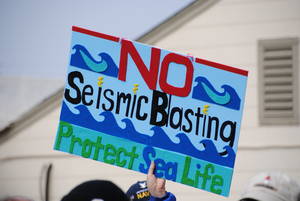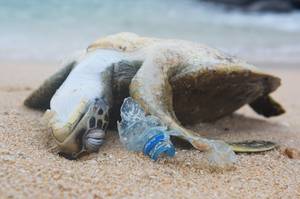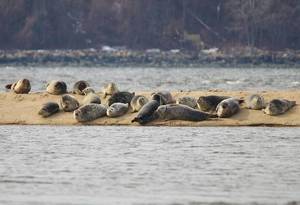S.O.S - Save Our Seas!
What lies ahead?
Actions we anticipate the Trump Administration to do:
1.) Issue five permits that will blast the ocean in search of oil which will shock and kill marine life from New Jersey to Florida.
2.) Finalize areas for offshore oil and gas drilling, which could include the Jersey Shore!
Consequences we anticipate the Trump Administration to ignore:
~Scattering fish from the relentless noise - fish catch rates decrease by 40 - 80% over hundreds of square miles around a single air gun array.
~Harm, harassment and death to all marine life from zooplankton to whales and everything in-between.
~Endangered Species at risk: 46 turtles were stranded following seismic testing in Israel. 31 of the 46 turtles died. The turtles were found with fluid, including blood, in their lungs indicative of seismic testing.
~The Trump Administration has rolled back Critical Environmental Protections Making the next BP Oil Spill more likely.
One of the thirty-one dead turtles following seismic testing in Israel.
To learn more about Seismic Airgun Blasting, view our Factsheet. To oppose the Trump Administration's agenda, sign our Petition.
Clean Ocean Action Co-Sponsored the Rally to Save Our Seas
On Monday March 18, Clean Ocean Action joined numerous concerned citizen groups, business associations, elected officials and students in Cape May to oppose offshore oil and gas / seismic testing activities in the Atlantic. Speakers and fellow sponsors called upon the Bureau of Ocean and Energy Management (BOEM) to deny permits requested by five companies to conduct seismic blasting in the Atlantic Ocean. Speakers also called upon the Trump Administration to halt any further interest in expanding offshore oil and drilling in the Atlantic. Speakers included Federal, state and local elected officials, concerned business owners, and environmental advocates.
The rally drew over 265 friends of the ocean including federal state and local officials, and high school students. The colorful rally included over a hundred hand-crafted signs defending the ocean and compelling the Trump Administration stop fossil fuel energy development in the ocean!
Waves of Opposition: New York Rally Against Seismic Blasting
The Coalition to Save Hempstead Harbor and other concerned citizens will hold a similar opposition rally on Earth Day, April 22, 2019, at 11 AM on Tappen Beach, Sea Cliff, NY. Congressman Tom Suozzi will speak at the rally in addition to the Oyster Bay Town Supervisor, Joseph Saladino. For more information please contact the Coalition to Save Hempstead Harbor (cshh@optonline.net).
Seismic Airgun Blasting: What is it and What are the Risks?
Click image to enlarge.
The importance of sound in the ocean
Many marine species rely on their ability to produce and interpret sounds in communication and locating prey. Increased human use of the ocean for a variety of industrial, commercial, recreational, research, and military purposes have contributed to rising ambient sound levels. This means that marine life must deal with a cacophony of man-made sounds when trying to communicate with one another - imagine the frustration you feel when shouting to a friend in a crowded room in order to be heard. Sources of human-caused noise in the ocean are many, and include military sonar, vessel traffic, construction activities like pile driving, and seismic airgun blasting.
What is seismic airgun blasting?
Seismic airgun blasting is a practice commonly used by the oil and gas industry to locate potential deposits deep beneath the seafloor; it is also used for research applications to map buried sediments. It involves an array of airguns being towed for up to several miles behind a vessel and blasting extremely loud pulses of compressed air into the water column and deep into the seabed. The reverberations that return to the vessel can then be interpreted to understand what lies beneath the seafloor. In order to obtain a comprehensive "picture," vessels blast seismic airguns every few seconds for days or weeks at a time.
Why should we care?
Seismic airgun blasting creates one of the loudest sounds in the ocean - on the order of 250 decibels. A decibel is a measure of the intensity of a sound, and uses a logarithmic scale (so, a sound that increases by 10 decibels is actually 10 times more intense). To put 250 decibels into context, the threshold at which humans feel pain is 130 decibels; a jet aircraft at takeoff is about 140 decibels! Noise travels faster and farther in seawater than in air - airgun noise has been recorded over 1,800 miles from its origin,1 which is almost double the distance from Cape May to Miami.
Seismic airgun blasting is a big threat to our ocean and the people and marine life that depend on it:
- Hearing and sound are integral to the survival of a variety of marine species - over 700 fish species use unique sounds to communicate,2 and many marine mammal species, such as dolphins, use echolocation to navigate and hunt.3
- Airgun blasts are damagingly loud, producing sound pressures that are several orders of magnitude louder than the threshold that is hazardous to human hearing.4 Depending on the frequency, intensity, and duration of a sound, temporary or permanent shifts in the hearing ability of treasured marine life, including whales, dolphins, seals, sea turtles, fish, and shellfish, can occur.
- Airgun blasts can disrupt or prohibit vital marine animal activities, including communication, migration, mating, feeding, and predator avoidance, and can lead to temporary or even permanent hearing loss.
- Seismic activity impacts marine fisheries, which account for over 43,000 jobs5 and $187 million total annual revenue in New Jersey alone,6 as it may result in habitat abandonment, reduced reproductive success, and hearing loss. In fact, commercial catch rates in some areas have been shown to decrease by 40-80% over hundreds of square miles around a single airgun array.7,8
View this infographic for a visual representation
Seismic can be a difficult topic to understand. Thanks to a COA volunteer, we have an infographic to give a visual representation of seismic airgun blasting.
Click image to enlarge.
______________________________________
References:
[1] Nieukirk, S.L., Stafford, K.M., Mellinger, D.K., Dziak, R.P., and Fox, C.G. 2004. Low frequency whale and seismic airgun sounds recorded in the mid-Atlantic Ocean. Journal of Acoustical Soc. of America.115:4:1832-1843.
[2] Transactions of the American Fisheries Society 137: 533-541, 2008
[3] http://www.afsc.noaa.gov/nmml/education/cetaceans/cetaceaechol.php
[4] http://www.asha.org/public/hearing/disorders/noise.htm
[5] http://www.st.nmfs.noaa.gov/Assets/economics/documents/feus/2011/FEUS%202011-Revised.pdf
[6] http://www.st.nmfs.noaa.gov/Assets/commercial/fus/fus12/FUS2012.pdf
[7] Engås, A., Løkkeborg, S., Ona, E., and Soldal, A.V. 1996. Effects of seismic shooting on local abundance and catch rates of code (Gadus morhua) and haddock (Melanogrammus aeglefinus). Canadian Journal of Fisheries and Aquatic Sciences53: 2238-2249.
[8] Skalski, J.R., Pearson, W.H., and Malme, C.I. 1991. Effects of sounds from a geophysical survey device on catch-per-unit-effort in a hook-and-line fishery for rockfish (Sebastes spp.). Canadian Journal of Fisheries and Aquatic Sciences 49: 1357-1365.





